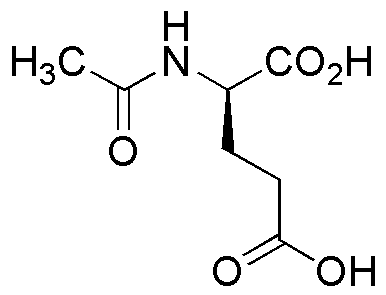N-Acetyl-D-Glutamic Acid is widely utilized in research focused on:
- Pharmaceutical Development: It serves as a precursor in the synthesis of various pharmaceuticals, particularly in the development of drugs targeting neurological disorders.
- Biochemical Research: This compound is used in studies investigating metabolic pathways and enzyme activity, helping researchers understand cellular processes more effectively.
- Food Industry: It acts as a flavor enhancer and preservative, improving the taste and shelf-life of various food products.
- Nutritional Supplements: Commonly included in dietary supplements, it supports cognitive function and overall brain health, making it popular among health-conscious consumers.
- Cosmetic Formulations: Its moisturizing properties make it a valuable ingredient in skincare products, enhancing hydration and skin texture.
General Information
Properties
Safety and Regulations
Applications
N-Acetyl-D-Glutamic Acid is widely utilized in research focused on:
- Pharmaceutical Development: It serves as a precursor in the synthesis of various pharmaceuticals, particularly in the development of drugs targeting neurological disorders.
- Biochemical Research: This compound is used in studies investigating metabolic pathways and enzyme activity, helping researchers understand cellular processes more effectively.
- Food Industry: It acts as a flavor enhancer and preservative, improving the taste and shelf-life of various food products.
- Nutritional Supplements: Commonly included in dietary supplements, it supports cognitive function and overall brain health, making it popular among health-conscious consumers.
- Cosmetic Formulations: Its moisturizing properties make it a valuable ingredient in skincare products, enhancing hydration and skin texture.
Documents
Safety Data Sheets (SDS)
The SDS provides comprehensive safety information on handling, storage, and disposal of the product.
Product Specification (PS)
The PS provides a comprehensive breakdown of the product’s properties, including chemical composition, physical state, purity, and storage requirements. It also details acceptable quality ranges and the product's intended applications.
Certificates of Analysis (COA)
Search for Certificates of Analysis (COA) by entering the products Lot Number. Lot and Batch Numbers can be found on a product’s label following the words ‘Lot’ or ‘Batch’.
Número de catálogo
Número de lote/lote
Certificates Of Origin (COO)
This COO confirms the country where the product was manufactured, and also details the materials and components used in it and whether it is derived from natural, synthetic, or other specific sources. This certificate may be required for customs, trade, and regulatory compliance.
Número de catálogo
Número de lote/lote
Safety Data Sheets (SDS)
The SDS provides comprehensive safety information on handling, storage, and disposal of the product.
DownloadProduct Specification (PS)
The PS provides a comprehensive breakdown of the product’s properties, including chemical composition, physical state, purity, and storage requirements. It also details acceptable quality ranges and the product's intended applications.
DownloadCertificates of Analysis (COA)
Search for Certificates of Analysis (COA) by entering the products Lot Number. Lot and Batch Numbers can be found on a product’s label following the words ‘Lot’ or ‘Batch’.
Número de catálogo
Número de lote/lote
Certificates Of Origin (COO)
This COO confirms the country where the product was manufactured, and also details the materials and components used in it and whether it is derived from natural, synthetic, or other specific sources. This certificate may be required for customs, trade, and regulatory compliance.


